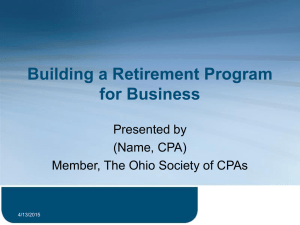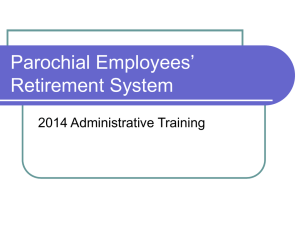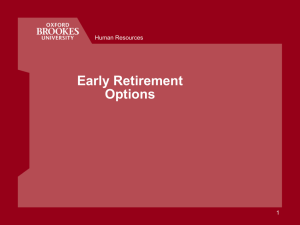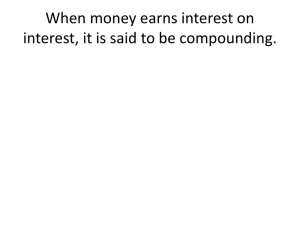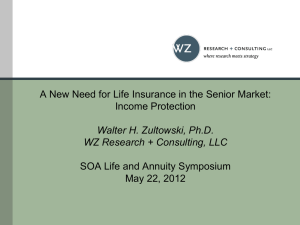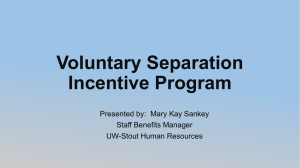for any cause beyond the control of said official and employee
advertisement
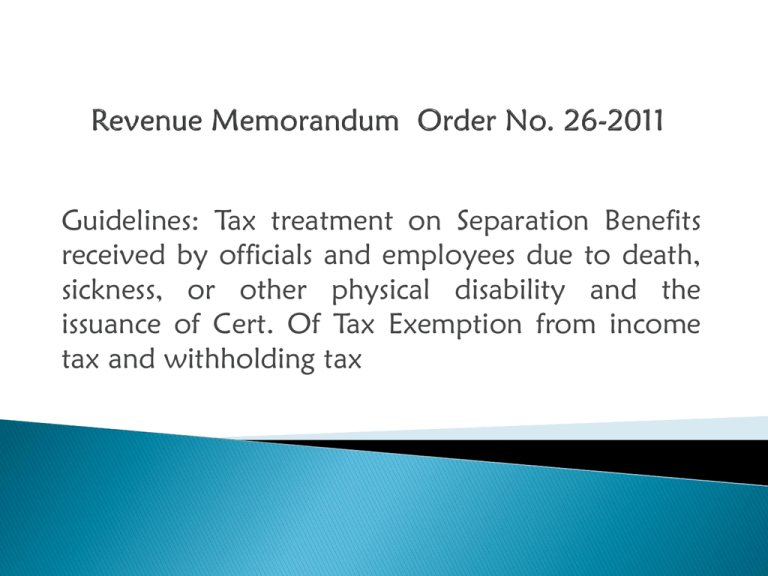
Guidelines: Tax treatment on Separation Benefits received by officials and employees due to death, sickness, or other physical disability and the issuance of Cert. Of Tax Exemption from income tax and withholding tax Sec. 32(B)(6)(b) NIRC: - any amount received by an official or employee or his heirs - due to death, sickness or physical disability, or for any cause beyond the control of the employee - shall be excluded from gross income and exempted from income tax - regardless of the age or length of service Before: Request for rulings from the Law Division of the National Office are secured by the separated employees of private entities, and submit to the employers as proof of exemption from income and withholding tax Now: - Certificate of Tax Exemption shall be issued by the Regional Director. - However, request for ruling is still processed in Legal Division, National Office. Documentary Requirements: 1. Letter request (employee, heir or employer); 2. Death – Certified true copy of Death Cert. 3. Sickness/Physical Disability: -Sworn affidavit of attending physician and employer’s head of office or representative; -Clinical Record -Laboratory examination or medical certificate (Checklist of Requirement) Separation Benefit is exempt from: - Income tax [Sec. 32(B)(6)(b) NIRC] and -withholding tax (Sec. 79 NIRC, RR 2-98, RR 6-01, RR 12-01) However, Income received prior to separation. Not exempt Private Retirement Benefit Plan Regulations Pursuant to Sec. 79(B) RA 4917 – exempts from all taxes the Retirement Benefits received by officials and employees of private firms under a reasonable private benefit plan maintained by the employer and all amounts received on account of involuntary separation (death, sickness, physical disability, any cause beyond control) (a) The plan must be reasonable; (b) Retiree must have been in service for at least 10 yrs and not less than 50 y.o. (c) Retiree have not availed of the privilege under a retirement benefit plan of the same or another employer - - Pension; Gratuity; Stock bonus; Profit-sharing plan (contributory on noncontributory on the part of the employee (a) (b) (c) Written Program – definite provisions essential for qualification; Permanency – permanent and continuing program; Coverage: Percentage Basis: – must cover >=70% of all officials & employees - (eligibility) 70% of all officials & employees and 80% of eligible must be covered - Excluding: (a) employed less than the minimum length of time stated in the plan; (b) works 20 hrs a week or less; (c) seasonal employees (=<5 mos.) (2) Classification Basis – with prescribed classification set-up and limit coverage * certain classification * prescribed age * years of employment (should not be discriminatory) (d) Contribution – employer, officials & employees or both contribute to a trust fund * with a purpose to distribute the corpus and income of the fund in accordance with the plan (e) Impossibility of Diversion – the corpus or income of the fund should not be diverted but only for the exclusive benefit of the officials or employees (f) Non-discriminatory – no discrimination in contributions or benefits; (g) Non-forfeitures – must provide for nonforfeitable rights on benefits or amount credited to his account; (h) Forfeitures – must provide that forfeitures must not be applied to increase the benefits any employee would receive at any time prior to the termination of the plan. Forfeited amounts must be used to reduce the employer’s contribution (i) Trust – retirement fund should be administered by a trust. INVOLUNTARY SEPARATION all amounts of separation benefit are EXEMPT From all terms and attachment, garnishment, levy, seizure except to pay a debt in a criminal action (a) Pension Plan – established plan by employer to provide systematically for the payment of determinable benefits after retirement (b) Profit-sharing Plan – plan to provide for the participation in the profits by employees or their beneficiaries; (c) Stock-Bonus Plan – similar to profit sharing except that contributions by employer is not dependent on profit. Benefits are distributable in stock. (d) Gratuity Plan – for payment of definitely determined benefits of the employees after retirement. Same as pension plan but benefits are paid immediately after retirement (e) “at no time shall any part of the corpus or income of the fund be used for, or diverted to, any purpose other than for the exclusive benefit of the said officials and employees” - includes all objects or aims not solely designed for the proper satisfaction of all liabilities to employees covered by trust (f) “for any cause beyond the control of said official and employee” - separation was not in his own making, not be asked for or initiated by him Note: Whether or not a separation is beyond the control of the official or employee, being essentially a question of fact, shall be determined on the basis of the prevailing facts and circumstances. INVESTMENT Generally, the fund may be used by the trustees to purchase any investments permitted by trust agreement. However, the exemption of the trust income under Sec. 56(b) of NIRC may be denied if: (a) Lends any part of it income w/o adequate security and reasonable rate of interest; (b) Pays any compensation in excess of a reasonable allowance for salaries for other personal services actually rendered; (c) Makes any part of its services available on a preferential basis; (d) Makes any substantial purchase more than adequate consideration in money or money’s worth; (e)Sells substantial part of its securities or properties for less than money’s worth; (f)Engages in any transaction whish results to diversion of its income or corpus; Determination of Qualification: - Before availing of the privileges afforded by the Plans, employers must submit to the CIR, fill out the BIR Form 17.60 and accompanied by written program constituting the plan and the trust instrument. Coverage of the exemption: - RA No. 4917, June 17, 1967 (Pls. See Retirement Benefit Plan Information Sheet attached in your hand outs)
